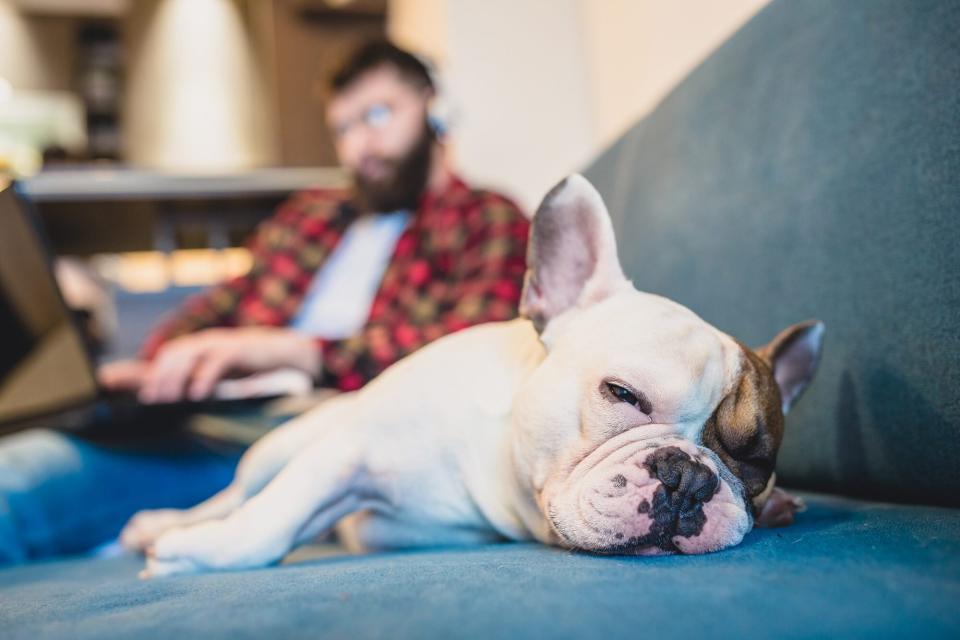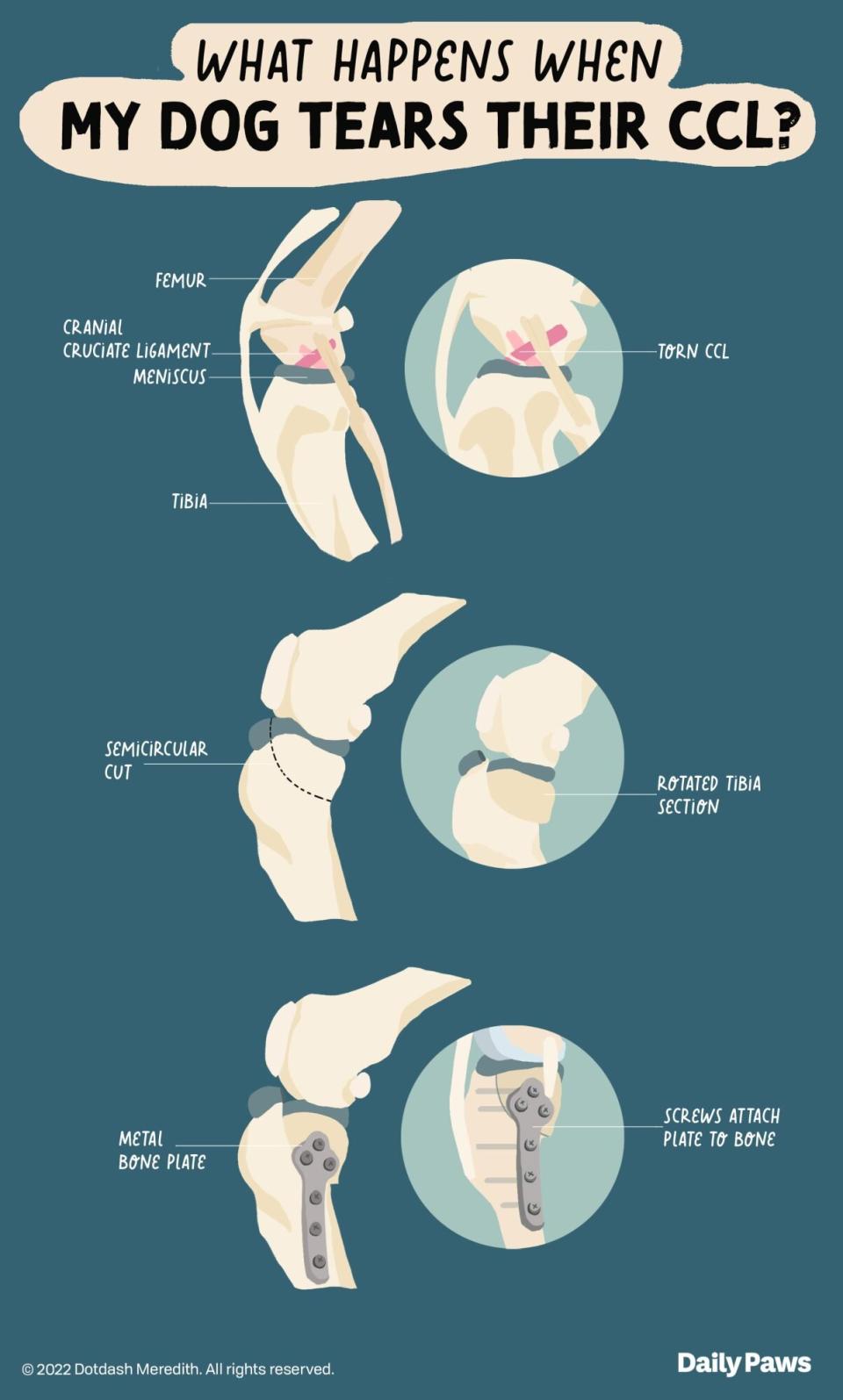What Happens If a Dog Gets a Torn ACL? Here's What to Expect If It Happens to Your Pup
TABLE OF CONTENTS
On This Page
Where Is a Dog's ACL?
Causes of Dog CCL Rupture
Dog Torn CCL Symptoms
Dog Breeds Most Susceptible to CCL Injuries
Dog Torn CCL Surgery and Recovery Time
Home Treatment Options for a Dog CCL Injury
What's the Outlook for a Dog With an ACL Injury?
A torn ACL is one of the most common orthopedic injuries in dogs. Just like a torn ACL in a person, these are fairly serious injuries that require time, rest, and immobilization to recover. An injury as severe as a torn ACL can be scary for owners to confront. However, with time and the right treatment, many dogs can fully recover from a torn ACL.
RELATED: Everything to Know About Dog ACL Surgery Costs
Where Is a Dog's ACL?
When we talk about a dog's ACL, we are actually talking about their CCL, or cranial cruciate ligament, which performs a similar function to the ACL (anterior cruciate ligament) in humans. The CCL connects from the back of the femur (the bone above the knee) to the front of the tibia (the bone below the knee), stabilizing the knee joint. Because it performs such a crucial task, a CCL rupture can permanently alter a dog's mobility.
Causes of Dog CCL Rupture
CCL ruptures can occur for a variety of reasons. In younger dogs, a traumatic injury can result in a CCL tear. Senior dogs can experience CCL tears from wear on their ligaments over their lifetime, so even a minor injury can result in a torn CCL. Nikki Graham, DVM from Nottingham Animal Hospital in Hamilton, N.J., says that many CCL injuries occur when dogs twist their knees. According to Graham, this can happen from running and turning quickly, jumping off of something high, or running and stepping in a hole or uneven surface. That twisting motion is what tears or breaks the ligament.
Dog Torn CCL Symptoms
Keep an eye out for limping in your dog, as this is one of the primary visible indicators that something is wrong with their knee joint. A partially torn CCL will usually result in limping, says Graham. If your dog tears their ligament completely, they won't be able to bear weight on that leg at all and will avoid stepping with it. You may also notice swelling around the knee. Usually, these injuries are acute, says Graham, meaning it occurs suddenly rather than slowly over time.

NoSystem images / Getty
Dog Breeds Most Susceptible to CCL Injuries
Any dog can injure their ACL, says Graham. However, she says, more serious injuries tend to happen in larger, muscular dogs, such as:
Overweight dogs of any breed are also more susceptible to these injuries, as there is more pressure on the ligament.
Dog Torn CCL Surgery and Recovery Time

Kailey Whitman If your dog tears their cranial cruciate ligament (CCL), as shown in the first row of images, they will most likely need surgery to fix it. Shown here is the tibial plateau leveling osteotomy (TPLO), the most common surgery performed with CCL tears. This surgery involves making a semicircular cut around the top of the tibia and rotating it forward approximately 90 degrees to reach a near level orientation, as shown in the second row of images. The cut and rotated bone is then held in place by a metal bone plate and screws, as shown in the last row of images. This process stabilizes the knee in the absence of the CCL.
According to Graham, the best treatment for large dogs that have a fully torn CCL is surgery. There are several surgeries that can be performed, one of the most common being a tibial plateau leveling osteotomy (TPLO), in which stress is taken off the joint as it is stabilized.
All surgical options are major orthopedic procedures and take many weeks of rest and immobilization to recover. A partial tear can heal without surgery, but the dog will likely suffer from pain and decreased mobility, as well as being more prone for a complete tear and degenerative joint diseases such as osteoarthritis in the future.
If you are unsure what treatment path you would like to pursue, you should discuss possible options with your veterinarian to ensure you are finding the best choice for you and your dog.
Home Treatment Options for a Dog CCL Injury
If you think your dog has a torn CCL, you should consult with a veterinarian before attempting to treat them at home. This is a serious injury, and improper treatment can lead to much worse outcomes for your dog. However, there are a few things you can do at home to aid the recovery process you and your vet agree on.
Strict rest and veterinary anti-inflammatory or pain medications can help considerably. Graham emphasizes that you should never give your dog aspirin or other human medications, as these can have dangerous consequences, including serious illness and even death. So get those meds from your vet.
RELATED: Can You Give Your Dog Tylenol?
If your dog is overweight, you can also ask your veterinarian if a diet change is the right choice for your dog to try to reduce some of the weight on the injured joints.
What's the Outlook for a Dog With an ACL Injury?
Graham says that with proper treatment, most dogs with ACL injuries will completely recover with time. Your veterinarian can also prescribe products to help protect your dog's joints, including glucosamine supplements, physical therapy, laser treatments, and acupuncture.
There are also several prescription diets for joint health that can benefit dogs with joint conditions, says Graham. It can take up to six months for a dog to return to their normal activity level after a CCL tear, but it is absolutely possible!

